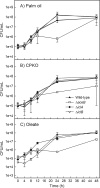Elucidation of beta-oxidation pathways in Ralstonia eutropha H16 by examination of global gene expression
- PMID: 20709892
- PMCID: PMC2950501
- DOI: 10.1128/JB.00493-10
Elucidation of beta-oxidation pathways in Ralstonia eutropha H16 by examination of global gene expression
Abstract
Ralstonia eutropha H16 is capable of growth and polyhydroxyalkanoate production on plant oils and fatty acids. However, little is known about the triacylglycerol and fatty acid degradation pathways of this bacterium. We compare whole-cell gene expression levels of R. eutropha H16 during growth and polyhydroxyalkanoate production on trioleate and fructose. Trioleate is a triacylglycerol that serves as a model for plant oils. Among the genes of note, two potential fatty acid β-oxidation operons and two putative lipase genes were shown to be upregulated in trioleate cultures. The genes of the glyoxylate bypass also exhibit increased expression during growth on trioleate. We observed that single β-oxidation operon deletion mutants of R. eutropha could grow using palm oil or crude palm kernel oil as the sole carbon source, regardless of which operon was present in the genome, but a double mutant was unable to grow under these conditions. A lipase deletion mutant did not exhibit a growth defect in emulsified oil cultures but did exhibit a phenotype in cultures containing nonemulsified oil. Mutants of the glyoxylate shunt gene for isocitrate lyase were able to grow in the presence of oils, while a malate synthase (aceB) deletion mutant grew more slowly than wild type. Gene expression under polyhydroxyalkanoate storage conditions was also examined. Many findings of this analysis confirm results from previous studies by our group and others. This work represents the first examination of global gene expression involving triacylglycerol and fatty acid catabolism genes in R. eutropha.
Figures




Similar articles
-
Engineering of Ralstonia eutropha H16 for autotrophic and heterotrophic production of methyl ketones.Appl Environ Microbiol. 2013 Jul;79(14):4433-9. doi: 10.1128/AEM.00973-13. Epub 2013 May 17. Appl Environ Microbiol. 2013. PMID: 23686271 Free PMC article.
-
Roles of multiple acetoacetyl coenzyme A reductases in polyhydroxybutyrate biosynthesis in Ralstonia eutropha H16.J Bacteriol. 2010 Oct;192(20):5319-28. doi: 10.1128/JB.00207-10. Epub 2010 Aug 20. J Bacteriol. 2010. PMID: 20729355 Free PMC article.
-
Characterization of an extracellular lipase and its chaperone from Ralstonia eutropha H16.Appl Microbiol Biotechnol. 2013 Mar;97(6):2443-54. doi: 10.1007/s00253-012-4115-z. Epub 2012 May 16. Appl Microbiol Biotechnol. 2013. PMID: 22588499
-
Design of inducible expression vectors for improved protein production in Ralstonia eutropha H16 derived host strains.J Biotechnol. 2016 Oct 10;235:92-9. doi: 10.1016/j.jbiotec.2016.04.026. Epub 2016 Apr 13. J Biotechnol. 2016. PMID: 27085887 Review.
-
Engineering the heterotrophic carbon sources utilization range of Ralstonia eutropha H16 for applications in biotechnology.Crit Rev Biotechnol. 2016 Dec;36(6):978-991. doi: 10.3109/07388551.2015.1079698. Epub 2015 Aug 27. Crit Rev Biotechnol. 2016. PMID: 26329669 Review.
Cited by
-
Applying Statistical Design of Experiments To Understanding the Effect of Growth Medium Components on Cupriavidus necator H16 Growth.Appl Environ Microbiol. 2020 Aug 18;86(17):e00705-20. doi: 10.1128/AEM.00705-20. Print 2020 Aug 18. Appl Environ Microbiol. 2020. PMID: 32561588 Free PMC article.
-
Engineering of Ralstonia eutropha H16 for autotrophic and heterotrophic production of methyl ketones.Appl Environ Microbiol. 2013 Jul;79(14):4433-9. doi: 10.1128/AEM.00973-13. Epub 2013 May 17. Appl Environ Microbiol. 2013. PMID: 23686271 Free PMC article.
-
Examination of PHB Depolymerases in Ralstonia eutropha: Further Elucidation of the Roles of Enzymes in PHB Homeostasis.AMB Express. 2012 Apr 26;2(1):26. doi: 10.1186/2191-0855-2-26. AMB Express. 2012. PMID: 22537946 Free PMC article.
-
Development of a broad-host synthetic biology toolbox for Ralstonia eutropha and its application to engineering hydrocarbon biofuel production.Microb Cell Fact. 2013 Nov 13;12:107. doi: 10.1186/1475-2859-12-107. Microb Cell Fact. 2013. PMID: 24219429 Free PMC article.
-
Genome characteristics dictate poly-R-(3)-hydroxyalkanoate production in Cupriavidus necator H16.World J Microbiol Biotechnol. 2018 May 24;34(6):79. doi: 10.1007/s11274-018-2460-5. World J Microbiol Biotechnol. 2018. PMID: 29799066 Review.
References
-
- Bartlett, K., and S. Eaton. 2004. Mitochondrial beta-oxidation. Eur. J. Biochem. 271:462-469. - PubMed
-
- Basiron, Y. 2007. Palm oil production through sustainable plantations. Eur. J. Lipid Sci. Technol. 109:289-295.
-
- Bramer, C. O., and A. Steinbuchel. 2002. The malate dehydrogenase of Ralstonia eutropha and functionality of the C(3)/C(4) metabolism in a Tn5-induced mdh mutant. FEMS Microbiol. Lett. 212:159-164. - PubMed
Publication types
MeSH terms
Substances
LinkOut - more resources
Full Text Sources
Other Literature Sources
Molecular Biology Databases

